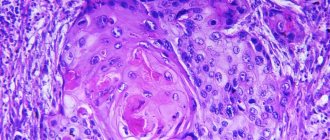The sigmoid colon is the final section of the colon. Below it passes into the rectum. Thus, malignant tumors of the sigmoid colon belong to colon cancer and to a larger group of oncological diseases that are combined under the general term “colorectal cancer.”
Our expert in this field:
Ibragimov Elkhan Kamranovich
Oncologist, chemotherapist, head of the oncology department
Call the doctor
Colon cancer with metastases is classified as stage 4 malignancy. Most often, secondary lesions occur in the liver and lungs.
Once a malignant tumor has metastasized, it becomes much more difficult to fight it, and the prognosis for a patient with sigmoid colon cancer with metastases to the liver worsens. But this is not a reason to give up; the patient can still be helped. At the Medicine 24/7 clinic, the most modern achievements of world oncology are used for this purpose.
Stages of sigmoid colon cancer
The stage of a malignant tumor of the sigmoid colon is determined in accordance with the generally accepted international TNM system. The letter T indicates the size of the primary tumor, how much it has grown into the wall of the organ, and how it has spread to neighboring structures. N - damage to regional lymph nodes, M - presence of distant metastases. Depending on various combinations of these three indicators, five stages of a malignant tumor are distinguished:
- Stage 0 - “cancer in situ.” Tumor cells are located within the mucous membrane and do not spread deeper.
- Stage 1 - the tumor has grown into the muscular layer of the sigmoid colon.
- Stage 2 - a malignant neoplasm has grown through the entire thickness of the intestinal wall.
- Stage 3 - cancer cells have spread to regional lymph nodes.
- Stage 4 - during the examination, distant metastases were discovered.
If metastases are found only in the liver (or in another - but only one - organ), it is stage VIA cancer. If more than one organ is affected, it is stage IVB. If tumor cells have spread over the surface of the peritoneum (this condition is called peritoneal carcinomatosis), this is stage IVC.
Clinical picture
As cancer progresses, symptoms begin to become more specific to the disease. If cancer develops against the background of precancerous pathology, then it can be difficult to trace the initial symptoms of a malignant neoplasm.
The classification of precancerous diseases of the sigmoid colon includes four diseases:
- Nonspecific ulcerative colitis.
- Crohn's disease.
- Intestinal polyps.
- Diverticula of the sigmoid colon (Hereditary pathology - diffuse familial polyposis).
The clinical picture also depends on the nature of the growth of the formation:
- Exophytic growth - when a tumor grows into the intestinal lumen, it is also called a polypoid, villous tumor or villous-papillary tumor.
- Endophytic growth - cancer grows in the thickness of the intestinal wall. It is divided into infiltrative, circular-structuring, ulcerative-infiltrative.
When analyzing symptoms, the size of the tumor, the degree of prevalence, and the morphological characteristics of the cancer are taken into account. It should be said that if the patient has a small tumor of the sigmoid colon, the symptoms may not be pronounced, and the detection of the disease will occur at a late stage.
The main symptoms that are alarming about a tumor of the sigmoid colon:
- Pain syndrome. The first thing that really worries the patient. The intensity of the pain can range from mild discomfort to excruciating pain that causes the patient to scream.
- Dyspeptic disorders manifest themselves in belching, nausea, vomiting, loss of appetite, heaviness in the abdomen.
- Pathological impurities in feces. Most often it is blood. Usually the blood is dark in color and of an altered nature, but not black loose stools or bright scarlet blood. Impurities may be visible to the naked eye, or they may be detected during a stool occult blood test.
- Stool disorders. Diarrhea is characteristic of the initial stage of sigmoid colon cancer. When the size of the tumor makes it difficult for feces to move along the tract, constipation occurs, up to the development of mechanical obstructive intestinal obstruction.
- Asthenia of the patient, that is, malaise, weakness, instability of blood pressure, weight loss, and the possible formation of cachexia. Cancer patients are often bothered by low-grade fever. This symptomatology is associated with intoxication syndrome, which develops as a result of tumor metabolism.
- In case of massive size of cancer and cachexia of the patient, it is possible to palpate the neoplasm through the abdominal wall. Localization of the pathology in the left iliac region.
The clinical picture of the disease may vary depending on the form of the disease:
- Toxic-anemic – characterized by the formation of anemia against the background of insufficient absorption of iron, as well as the development of intoxication syndrome.
- Obstructive - stenotic - when cancer (villous tumor) blocks the lumen of the intestine, formed feces cannot pass further along the tract, mechanical intestinal obstruction develops. Its manifestations include prolonged constipation, expansion of the intestine to the site of obstruction and narrowing at the site of tumor growth. The patient complains of intense abdominal pain, nausea, belching, possibly with a fecal odor. Objectively, an enlarged intestine and a dense formation can be palpated in the left half of the abdomen. As intestinal obstruction progresses, intestinal peritonitis develops - rupture of the intestinal wall with the release of feces into the abdominal cavity. With prolonged stagnation, the contents of the intestines begin to be absorbed into the blood, causing severe intoxication.
- Dyspeptic - disturbance of digestion and absorption of substances, slowing down or increasing intestinal motility and peristalsis.
- The pseudoinflammatory form is diagnosed in the case of positive symptoms of peritoneal irritation.
Also, the symptoms of the developed process will be supplemented by the clinic from the organs affected by metastases of colon cancer, if any.
Dropouts spread in three ways:
- With lymph flow into groups of lymph nodes:
- Epi - and paracolytic.
- Mesenteric.
- Retroperitoneal.
- With the blood flow, internal organs are affected, and the cancer is stage 4:
- Sigmoid colon cancer with liver metastases.
- Sigmoid colon cancer with metastases to the lungs.
- Cancer of the sigmoid colon with metastases to the bones: most often to the spine, sacrum, coccyx.
- Sigmoid colon cancer with metastases to the brain.
- The contact path causes the development of damage to the peritoneum by cancer cells - carcinomatosis and, as a result, ascites. Cancer can also invade the intestine and invade the bladder.
How does sigmoid colon cancer metastasize to the liver?
Liver metastases in colorectal cancer are quite common because this organ collects blood from the intestines through the portal vein. Tumor cells spread hematogenously: they break away from the primary lesion, penetrate the blood vessels, migrate with the bloodstream, then leave the vascular bed, settle in the liver tissue and give rise to secondary lesions.
According to statistics presented in the Euroasian Journal of Hepato-Gastroenterology in 2021, at the first visit to the doctor, from 14 to 18% of patients with colon and rectal cancer already have metastases in the liver. At the time of tumor resection, metastatic liver damage is detected in 10–25% of patients. It will eventually occur in 70% of patients with colorectal cancer.
Diagnostics
The diagnosis must be made by a proctologist. At the initial visit, the doctor interviews and examines the patient. Analyzing the patient's complaints about general weakness, pain in the left iliac region, weight loss, streaks of scarlet blood in the stool, one can suspect the involvement of the lower intestines. Upon visual examination, such a patient may be pale (anemic) and emaciated. Palpation reveals pain in the left iliac region. If the polyp is large in size, then upon palpation you can feel the formation in this location.
During laboratory tests, stool analysis is of greatest importance. When examining stool, streaks of scarlet blood are found in them. Color matters a lot. For example, if the upper gastrointestinal tract is damaged, the blood will be dark. If the bleeding is not intense, then an occult blood test will be needed.
Of the instrumental methods, the most relevant is irrigoscopy. This manipulation allows you to assess the patency and condition of the walls of the colon. For irrigoscopy, it is necessary to perform a retrograde (through the rectum) injection of a contrast solution, followed by visualization using an X-ray machine. This technique allows you to fix a polyp larger than 10 mm. To detect tumors less than 10 m2, you can use colonoscopy.
Endoscopic research methods are performed with special optical instruments inserted into the lumen of hollow organs. Colonoscopy allows you to evaluate the condition of the gastrointestinal tract from the rectum to the ileocecal angle. This manipulation is prescribed if there is a suspicion of the presence of polypous formations in the upper parts of the digestive tract.
Symptoms of liver metastases in sigmoid colon cancer
The liver is a large organ, and even if it has a fairly large tumor node, it can often still successfully cope with its functions. Therefore, metastases may not cause symptoms for a long time. The presence and severity of symptoms depend on the size, number, and location of tumor foci. Most often, patients present the following complaints:
- increased fatigue, constant feeling of tiredness;
- loss of appetite;
- nausea;
- weight loss for no apparent reason, up to a state of exhaustion (cachexia);
- increase in body temperature to 38⁰ C or more;
- pain, discomfort in the abdomen;
- enlargement of the abdomen due to the accumulation of fluid in the abdominal cavity (ascites);
- swelling in the ankle area.
If the tumor disrupts the flow of bile, a serious complication develops - obstructive jaundice. The toxic breakdown product of hemoglobin - bilirubin - cannot be excreted with bile into the intestines, and its level in the blood increases. Because of this, the skin and whites of the eyes acquire a yellow tint, causing itchy skin. Uncontrolled obstructive jaundice aggravates the course of cancer and worsens the prognosis for the patient.
You can always help. Call today
Diagnostic methods
Various diagnostic techniques help to detect tumor nodes in the liver:
- Ultrasound examination is the fastest, simplest and most affordable. It helps detect growths that may be cancer, after which the doctor refers the patient for further testing to confirm the diagnosis.
- Computed tomography is a highly informative diagnostic method using x-rays. It helps to accurately determine the size, number, and location of metastases in the liver tissue. A CT scan of the chest can be performed at the same time as the liver: the lungs are the second most common site where distant metastases are found in sigmoid colon cancer.
- Magnetic resonance imaging has the same benefits as CT scanning, but uses a magnetic field instead of X-rays. Sometimes MRI can help distinguish malignant tumors from benign ones without a biopsy.
- Angiography is a radiopaque study. A contrast solution is injected into the vessels feeding the tumor in the liver, after which X-rays are taken. Angiography is mainly performed to determine whether the tumor is operable and to properly plan surgical intervention.
- PET scanning is the current gold standard in the search for distant metastases, not only in the liver, but also in other organs. During the study, a safe radiopharmaceutical is introduced into the patient's body, which accumulates in tumor cells. Then, using a special apparatus, images are taken, and all tumor foci are clearly visualized. Positron emission tomography is especially informative when combined with computed tomography (PET-CT).
Diagnosis must be reasonable!
We will select the research that you need, and right now!
The diagnosis is confirmed with a biopsy: during this procedure, the doctor obtains a fragment of tumor tissue and sends it to the laboratory, where cytological and histological examination is carried out. The material can be obtained using a needle (puncture biopsy) inserted into the liver directly through the skin under ultrasound or computed tomography guidance. Sometimes a laparoscopic biopsy is performed during therapeutic or diagnostic laparoscopy. Sometimes surgeons remove the tumor first and then examine it in a laboratory. If part of the tumor is removed, such a biopsy is called incisional, if the entire tumor with surrounding tissue is called excisional.
Prevention
Prevention measures include, first of all, the earliest possible detection of the disease. People aged 50 years or older are recommended to have a colonoscopy every 5 years and a stool occult blood test once a year. If there is a hereditary predisposition, these measures should be taken starting from the age of 40.
If polyps appear in the colon and sigmoid colon with a diameter of more than 1 cm, they must be removed immediately; if their size is smaller, regular monitoring by a doctor is recommended.
You should not delay treatment of any inflammatory bowel disease.
Giving up bad habits, an active lifestyle, and getting rid of excess weight play a positive role.
Note! No traditional medicine or “grandmother’s recipes” can cope with sigmoid colon cancer. The sooner you seek qualified medical help, the higher the chances of recovery.
Surgery
For single metastatic foci, surgical intervention can be performed - liver resection. The doctor removes the part of the organ affected by the malignant tumor. Most often, this operation is performed openly, through an incision. Few clinics practice laparoscopic liver resection.
The surgery lasts for several hours and is quite complex. In order for the patient to undergo it, he must have satisfactory general health and liver function.
Chemotherapy for sigmoid colon cancer with liver metastases
Chemotherapy drugs are often used for liver metastases caused by sigmoid colon cancer. They are prescribed before surgery to reduce the size of the tumor and facilitate its removal, after surgery to reduce the risk of relapse, as an independent treatment method to slow the progression of the disease and improve the patient's condition.
Chemotherapy for sigmoid colon cancer with liver metastases is carried out in different ways:
- Systemic chemotherapy is when drugs are administered intravenously or the patient takes them in pill form. Intra-arterial chemotherapy - drugs are injected into the blood vessel feeding the tumor. This method is usually used when metastatic foci of sigmoid colon cancer are only in the liver and cannot be removed surgically.
- Chemoembolization is carried out as intra-arterial chemotherapy, but together with the chemotherapy drug, an embolizing drug in the form of microspheres is administered; it blocks the lumen of small vessels and disrupts the flow of oxygen and nutrients to the tumor tissue.
Treatment
Surgery is considered the most effective treatment for sigmoid colon cancer. In this case, as a rule, an integrated approach is used, including not only the surgical method, but also chemotherapy and radiotherapy.
Small cancerous tumors with clearly defined borders are removed along with part of the affected colon and nearby lymph nodes. After such an operation, the surgeon restores the integrity of the intestinal tube.
Tumors in stage IV cancer are most often removed along with the sigmoid colon, then a colostomy is performed - an artificially created anus by bringing the end of the colon out. In some cases, this is a temporary measure; sometimes the colostomy becomes permanent, and the patient wears a colostomy bag for the rest of his life.
Chemotherapy is used to kill cancer cells using drugs that can inhibit their ability to divide rapidly. The method can be effective even in advanced forms of the disease, and is used both before and after surgery.
At the same time, chemotherapy cannot be considered an alternative to surgery: it can only reduce the size of a cancer tumor and slow down its growth. It can be used as an independent therapeutic method when it comes to inoperable patients.
Radiotherapy, or radiation, also reduces the size of the tumor in the preoperative period, with its help it destroys cancer cells remaining at the border of healthy and diseased tissues.
Radiation therapy
Radiation therapy is sometimes used for sigmoid colon cancer with liver metastases as a palliative treatment to improve the patient's condition. But it is rarely used because the radiation can damage liver tissue.
Some patients are candidates for radioembolization, a procedure that works in a similar way to chemoembolization. An embolic drug in the form of radioactive microspheres is used. They clog the lumen of the vessels feeding the tumor and irradiate cancer cells, practically without affecting healthy tissue.
Symptoms (signs)
Features of the symptoms of sigmoid colon cancer are the rather slow development of the disease; its clinical manifestations can appear only several years after the onset of malignant degeneration of cells.
Note! The likelihood of a complete recovery is high if oncological processes are detected in the early stages. But when nothing bothers the patient, he is in no hurry to undergo examination, and the disease progresses in a latent form.
In most cases, sigmoid colon cancer manifests itself with the following symptoms:
- the normal process of defecation is disrupted;
- stool may be delayed for several days, the intestines have to be emptied in several stages, constipation sometimes alternates with diarrhea;
- discharge from the anus may appear in the form of blood and mucus;
- a person develops weakness, increased fatigue, the skin turns pale (may acquire an earthy-gray tint);
- shortness of breath and palpitations are not excluded;
- sensations of discomfort from bloating, the appearance of pain in the left half and lower parts of the abdominal cavity.
As the tumor grows, symptoms progress: acute intestinal obstruction and bleeding from the tumor may appear. Classic manifestations of advanced sigmoid colon cancer are expressed by severe cramping pain, bloating, lack of passage of stool and gas, and vomiting.
Targeted therapy
Targeted drugs target molecules that play an important role in the proliferation and survival of tumor cells. For sigmoid colon cancer with liver metastases, two targeted drugs are used:
- Bevacizumab (Avastin) blocks VEGF - this substance stimulates the growth of new blood vessels, which are needed to nourish tumor cells.
- Cetuximab (Erbitux) blocks EGFR, a receptor protein on the surface of tumor cells that stimulates their proliferation.
Most often, targeted therapy with these drugs is prescribed in combination with classical chemotherapy.
Etiology and pathogenesis
Experts admit that it is hardly possible to identify a single, universal cause for sigmoid colon cancer. In most cases, we are talking about a combination of various unfavorable conditions.
One of the main factors in the appearance of this type of cancer is the characteristic location of the sigmoid colon itself. Located at the end of the large intestine, it practically passes into the rectum and ends at the anus. Accumulating in the sigmoid colon, feces are in contact for a long time with the mucous membrane, which absorbs toxins and carcinogens from them, which provoke the development of cancer.
The risk of developing the disease increases if a person has relatives with intestinal cancer in their family. Risk factors also include various chronic inflammatory diseases of the large intestine, such as Crohn's disease, chronic colitis, ulcerative colitis, and diverticulosis.
Often, chronic polyps in the large intestine can become malignant. Cancer of the sigmoid colon can develop against the background of a decrease in peristalsis - muscle contractility; this phenomenon can be age-related (senile), and also occurs as a result of a sedentary lifestyle, previous surgery, or long-term medication use.
An unbalanced diet (the predominance of products containing carcinogenic food additives), nicotine and alcohol abuse play a negative role.
Ablation techniques
In some cases, liver metastases from sigmoid colon cancer can be destroyed using radiofrequency ablation (RFA). During this procedure, an electrode is inserted into the tumor, a high-frequency current is applied to it, as a result, the tissue becomes very hot and literally evaporates. This method can be applied under certain conditions:
- There are no more than 5 nodes in the liver, the largest diameter of each of them is no more than 4 cm.
- Absence of distant metastases in other organs.
- The tumor can be seen using ultrasound, computed tomography - under the control of one of these methods, a needle-electrode is inserted.
- The nodes are located at a safe distance (at least 1 cm) from the portal, hepatic veins, and lobar bile ducts. In addition to RFA, cryoablation is used - destruction of nodes using low temperature.
Forecast
The likelihood of successful treatment of patients with sigmoid colon cancer is directly dependent on the stage at which the disease was discovered.
After starting treatment at stage I, the prognosis for complete recovery is about 95%. If cancer is detected and treated at stage II, the five-year survival rate of patients is more than 90% in the absence of metastases and 83% with their appearance. The third stage corresponds to the following indicators: 59% of patients live after treatment for five years or more, if there are no metastases, when they are already present - 40%. After all treatment measures carried out, 8% of patients survive in stage IV.










